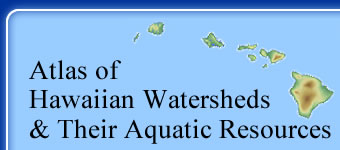
Key to Methods - Watershed Ratings
Land Cover Rating: In general, this rating scores the amount of forested lands positively and the amount of developed lands negatively in a watershed, and other land cover types are assumed to have a neutral association with stream quality. Specifically, the percent of land cover type within the watershed was multiplied by a value to weight the land cover type with respect to its positive or negative value associated with a high quality stream. These values are:
- Evergreen Forest: +1
- Estuarine Forested Wetland: +1
- Palustrine Forested Wetland: +1
- Estuarine Forested Wetland: +1
- Palustrine Emergent Wetland: +1
- High Intensity Developed: -4
- Low Intensity Developed: -2
- Cultivated Land: -1
- Bare Land: -1
- Grassland: 0
- Palustrine Scrub/Shrub Wetland: 0
- Scrub/Shrub: 0
- Unconsolidated Shore: 0
- Unclassified: 0
- Water: 0
The higher negative values for High Intensity Developed and Low Intensity Developed lands reflect the typical increase in pollution, sedimentation, discharge modification, and habitat degradation in comparison with streams near cultivated lands.
Shallow Waters Rating: This rating reflects the extent of estuarine and shallow marine waters associated with the stream. The length of the estuary and length from the stream mouth to the 60-ft contour line (10 fathoms) was measured and combined to estimate the amount of interaction the freshwater would have with the estuary and nearshore environments. Each category (estuary and shallow nearshore marine waters) is standardized prior to combining to weigh each category equally in the rating. This rating assumes that a stream with more associated shallow water would have greater habitat diversity than a stream that empties nearly directly into deep ocean waters.
Stewardship Rating: This rating scores the stewardship categories as 1 = no biodiversity protection; 2 = protected but unmanaged; 3 = managed for multiple uses; and 4 = biodiversity protection. The percent of land in each category is multiplied by the weighting score, and the sum for the watershed is calculated. The overall sum is standardized to provide the rating.
Size Rating: This rating compares stream size. This rating combines the standardized overall length of a stream with the standardized stream order to estimate stream size. This rating assumes a larger stream with more tributaries has more habitat than a smaller stream.
Wetness Rating: This rating compares the average annual rainfall within a watershed to estimate the wetness of a watershed. The mean value for the average annual rainfall within the watershed is used for comparison with other watersheds. This rating assumes that a wetter watershed will have a larger stream with more stable flow than a drier watershed and less consistent flow.
Reach Diversity Rating: This rating examines the type and extent of reaches within the stream to provide an estimate of the amount of different habitat types in the stream. First, the number of reach types with at least 1 km and less than 2 km of stream length are counted for each watershed. Next, the number of reach types with greater than 2 km of stream length are counted for each watershed. The two counts are combined by multiplying the second count by 2 and adding this to the first count. This rating assumes that higher reach diversity will result in more habitat types and that the longer lengths of these reach types support more habitat than shorter sections of the reach types.
Total Watershed Rating: This rating combines the standardized ratings for Land Cover, Shallow Waters, Stewardship, Size, Wetness, and Reach Diversity to estimate the overall quality of the watershed and its stream with respect to the overall amount and diversity of aquatic habitats.